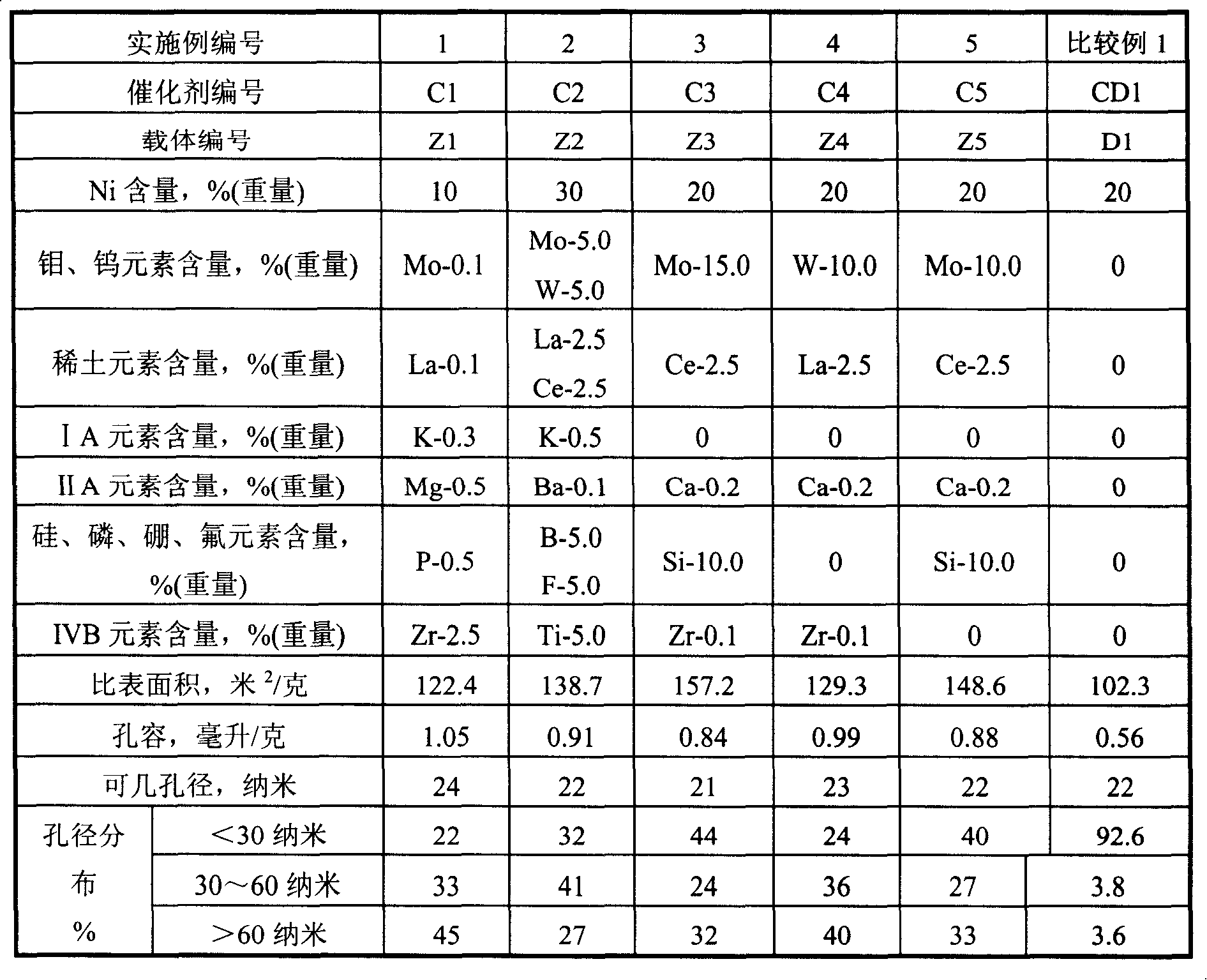Nickel catalyst with composite pore structure used for selective hydrogenation
A nickel catalyst and composite pore technology, which is applied in refining to remove heteroatoms, etc., can solve problems such as poor stability, low gel capacity, and poor anti-interference ability, and achieve good anti-interference and good low-temperature activity.
- Summary
- Abstract
- Description
- Claims
- Application Information
AI Technical Summary
Problems solved by technology
Method used
Image
Examples
Embodiment 1
[0015] Take by weighing 300 grams of pseudo-boehmite, 150 grams of α-alumina, and 9 grams of scallop powder, mix, then add 25 grams of polyvinyl alcohol-containing solution (mass concentration is 5%), 4.0 grams of nitric acid, and the concentration is 85% 1.8 grams of phosphoric acid, 1.5 grams of potassium nitrate, and 360 milliliters of aqueous solution of 2 grams of magnesium nitrate were extruded into clover with a diameter of 2.5 mm. The wet strip was dried at 120° C. for 4 hours and then roasted at 1150° C. for 2 hours to obtain carrier Z1. Weigh 2.5 grams of ammonium molybdate, 1.0 grams of lanthanum nitrate, 4.0 grams of zirconium nitrate, add 130 grams of water, and mix with 50 grams of nickel solution with a concentration of 14% to prepare an impregnation solution. The carrier was impregnated in an equal amount in the impregnation solution, dried at 60°C for 8 hours, and calcined at 450°C for 4 hours to obtain Ni-based catalyst C1, so that the final Ni content was 10....
Embodiment 2
[0017]Carrier Z2 was used, and the preparation method of the carrier was the same as in Example 1, and the composition of the carrier was shown in Table 1. Weigh 10.0 grams of ammonium molybdate, 5.0 grams of ammonium tungstate, 3.5 grams of lanthanum nitrate, 3.0 grams of cerium nitrate, 4.5 grams of titanium chloride, 2.0 grams of potassium borohydride, 3.0 grams of potassium fluoride, add 30 grams of water, and the concentration is Mix 150 grams of 14% nickel solution to make the dipping solution. Ni-based catalyst C2 was prepared with the same operating steps and conditions as in Example 1, so that the final Ni content was 30.0% by weight of the carrier alumina. The catalyst composition, specific surface area, pore volume, and pore size distribution are shown in Table 1, and the content of each component is based on the weight of the carrier alumina.
Embodiment 3
[0019] Take by weighing 300 grams of pseudo-boehmite, 45 grams of diatomite, and 9 grams of scallop powder, mix, then add 25 grams of polyvinyl alcohol solution (mass concentration is 5%), 3.5 grams of nitric acid, and 1.0 grams of calcium nitrate. 360 milliliters of aqueous solution was extruded into a clover with a diameter of 2.5 mm, and the wet strip was dried at 50° C. for 24 hours and then calcined at 750° C. for 4 hours to obtain carrier Z3. Weigh 25 grams of ammonium molybdate, 3.0 grams of cerium nitrate, 0.5 grams of zirconium nitrate, add 80 grams of water, and mix with 100 grams of nickel solution with a concentration of 14% to form an impregnation solution. Ni-based catalyst C3 was prepared with the same operation steps and conditions as in Example 1, so that the final Ni content was 20.0% by weight of the carrier alumina. The catalyst composition, specific surface area, pore volume, and pore size distribution are shown in Table 1, and the content of each componen...
PUM
 Login to View More
Login to View More Abstract
Description
Claims
Application Information
 Login to View More
Login to View More - R&D
- Intellectual Property
- Life Sciences
- Materials
- Tech Scout
- Unparalleled Data Quality
- Higher Quality Content
- 60% Fewer Hallucinations
Browse by: Latest US Patents, China's latest patents, Technical Efficacy Thesaurus, Application Domain, Technology Topic, Popular Technical Reports.
© 2025 PatSnap. All rights reserved.Legal|Privacy policy|Modern Slavery Act Transparency Statement|Sitemap|About US| Contact US: help@patsnap.com



